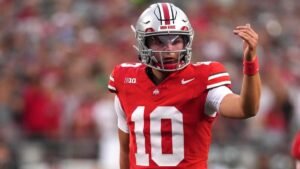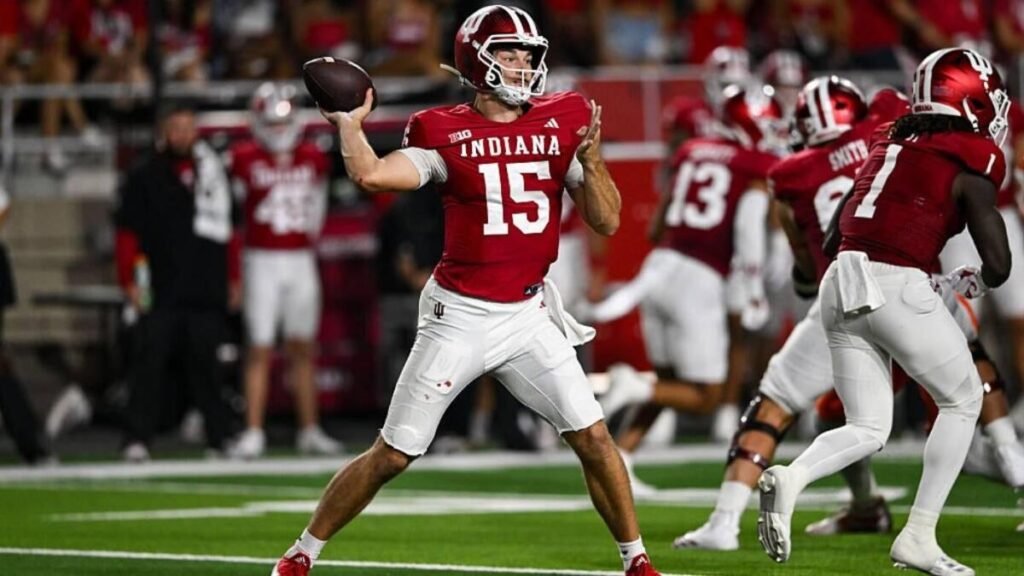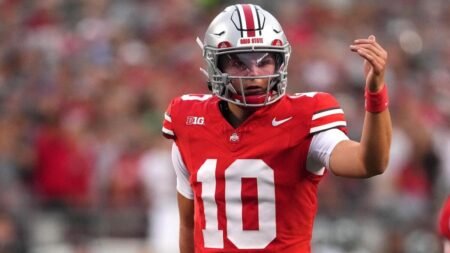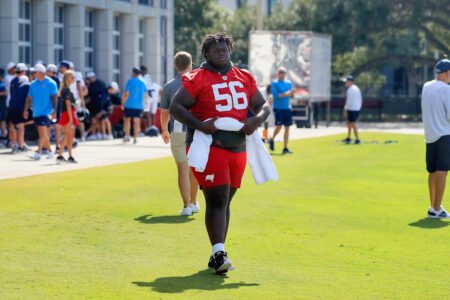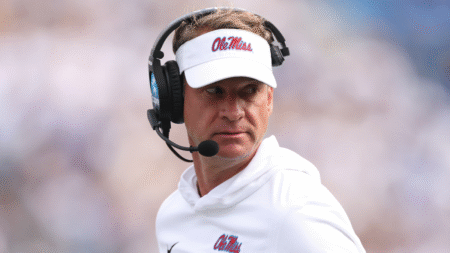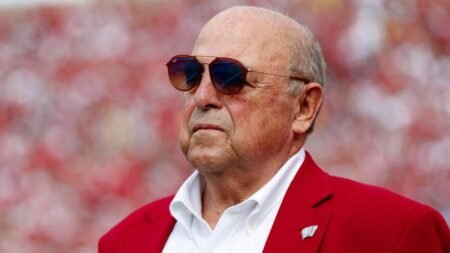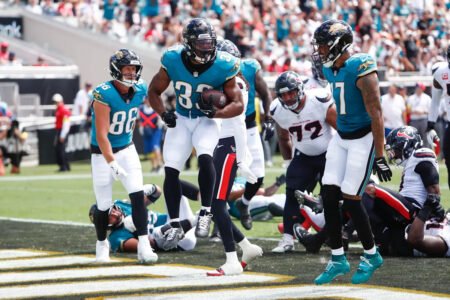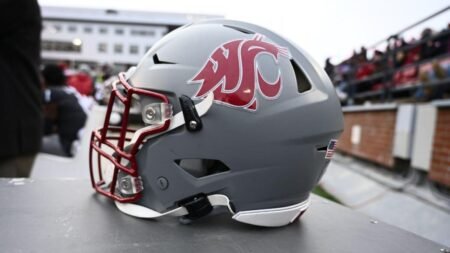The Big Ten has long held a reputation for being “old school.” It was the league of “three yards and a cloud of dust” football. A lot has changed in the league in recent years, and it’s not just due to expansion and realignment. It’s the style of play on the field, too.
Now it’s fair to wonder if the Big Ten has become the conference of quarterbacks.
We’re still incredibly early in the season, and things are likely to change once we get into the meat of conference play. However, most Big Ten fans can look at their quarterback situation and feel confident about what they have going forward.
As we enter week five, the top five qualified quarterbacks in passer efficiency all call the Big Ten home. There’s no way I can fact-check this, but I am confident that this is probably the only time it has ever happened. I’m sure the Big 12 has done it before, and the Pac-12 probably did as well, but not the Big Ten.
And it doesn’t stop with those top five. Nebraska’s Dylan Raiola checks in at 14. Illinois’ Luke Altmyer is right behind him at No. 15 — even after the disaster against Indiana. Michigan State’s Aidan Chiles is 18th.
Furthermore, I’ve been tinkering with a new QB metric of my own. One, I believe, that does a better job of considering the different things quarterbacks in different offenses are asked to do. It’s a work in progress (so much so that I haven’t named it yet), but while it’s not as emphatic about the Big Ten as passing efficiency, four of the top six are Jayden Maiava, Dante Moore, Fernando Mendoza and Julian Sayin. It’s also much higher on Minnesota’s Drake Lindsey and Maryland’s Malik Washington. Here’s a graphical representation of how the Big Ten’s QBs compare to the rest of the country in both.
There’s also Rutgers’ Athan Kaliakmanis, who ranks 25th in my metric and 26th in passer efficiency. According to PFF, Kaliakmanis has made 11 Big Time Throws (which ties him for third nationally), but he’s done so without a single turnover-worthy throw. Kaliakmanis is the only QB in the country to make more than six Big Time Throws without a single turnover-worthy one. Perhaps that’s why Kaliakmanis has the highest PFF grade of any QB with at least 100 dropbacks this season.
There are also a couple of freshman Big Ten quarterbacks whose stats are somewhat misleading. Maryland’s Malik Washington has been a revelation, but his completion rate is only 59.7%. Michigan’s Bryce Underwood is at 56.9%. Those numbers would look a lot different if Maryland receivers hadn’t dropped 13 passes (most in the Power Four) or if Michigan’s hadn’t dropped 11 (second-most in the Power Four). Take away those attempts (we aren’t assuming they were catches, just removing the attempts) and Washington’s completion rate jumps to 66.1% while Underwood’s moves to 63.7%.
If you want to look outside the statistics, take a look at the current Heisman odds. At Fanduel, your current Heisman favorite is Indiana’s Fernando Mendoza. Oregon’s Dante Moore is third. Ohio State’s Julian Saying, USC’s Jayden Maiava, and Penn State’s Drew Allar are all currently at 25-to-1 or better as well, putting them in the top 16.
Another thought I cannot fact-check, but I will say this is the first time in history the Big Ten has had six QBs within the top 16 Heisman favorites — seven players overall (Jeremiah Smith has the same odds as Moore) — and not a single one was a running back.
As I said, the numbers will change as all these players begin facing Big Ten defenses every week, but as nonconference play wraps up, it’s hard to argue that quarterback play in the Big Ten isn’t at an all-time high.
A critical clash
Penn State and Oregon will meet this week in the biggest Big Ten game of the season so far, as it’s a rematch of last year’s Big Ten Championship Game. It’s not a must-win for either team as far as winning the conference or reaching the College Football Playoff, but it kind of feels like one for Penn State, doesn’t it?
While James Franklin and the Nittany Lions will do their best to dismiss the situation all week, there’s no question that the program’s failures in these types of games loom like an elephant-sized monkey on their back (or would it be a monkey-sized elephant in the room? Not intimidating, but a distraction all the same).
Penn State fans, feel free to skip to the next section, because I’m about to share a bunch of trends you’re already too familiar with. James Franklin is 2-20 against AP top-six teams, which is the second-worst record by anyone who has coached in at least 20 such games. The worst record belongs to former Virginia Tech coach Frank Beamer, who went 2-24 in such contests. At Penn State, Franklin is 2-17 and has lost 14 straight.
Yes, Penn State reached the Big Ten title game last year, but it lost, just like it did to Ohio State in the regular season. And, yes, Penn State won two playoff games, but it won them against SMU and Boise State. When it ran into Notre Dame, it lost.
The perception that Penn State beats the teams it’s supposed to beat but falters against opponents at its level or better will linger until the Nittany Lions change it. That’s why, even with all the talk about returning talent and experience — and the addition of Jim Knowles as defensive coordinator — every compliment this offseason came with a familiar caveat: yeah, but.
Saturday night, at home, will be Penn State’s first chance this season to put those “yeah, buts” behind them. It will be a White-Out game, which have gone very well for the Nittany Lions. They’ve won their last six White-Out games, but it must be pointed out that while four of the opponents the Lions beat in those games were ranked, none were ranked higher than No. 10, and that was SMU in last year’s playoff game. The other ranked teams were No. 16 Michigan (2019), No. 22 Auburn (2021) and No. 24 Iowa (2023).
If Penn State wins, they immediately change from a potential national title threat to a legitimate title threat. If the Lions lose, well, I guess it won’t be anything they aren’t used to by now.
Speaking of the same old, same old
Saturday felt like a big moment for Nebraska. The Cornhuskers were already 3-0 with a season-opening win over Cincinnati, but hosting Michigan at Memorial Stadium was the kind of stage that could signal a return to national relevance.
It didn’t happen. Nebraska lost 30-27, and the score didn’t reflect how thoroughly it was beaten up front. Michigan ripped off three touchdown runs of 37 yards or longer, while the Huskers managed just 1.4 yards per carry after Dylan Raiola was sacked seven times. The loss doesn’t erase progress under Matt Rhule, but any notion of Nebraska as a serious conference or playoff contender vanished.
The final margin flattered the Huskers. They got a Hail Mary touchdown to close the first half and another score late with Michigan in clock-killing mode. The Wolverines even left points on the field, including a dropped end-zone pass from Bryce Underwood to Channing Goodwin.
Nebraska is improving. But Saturday showed how far the program still has to go.
Where’s the Indiana talk?
I swear, I’m not ignoring Indiana’s 63-10 beatdown of Illinois because I’m an Illini. I haven’t mentioned it here because I’ve written about it twice already. So if you’re an Indiana fan looking to receive some flowers, you can read what I wrote about the Hoosiers in my CFP Vibe Check on Sunday, as well as in my power ratings this week
Tom Fornelli’s College Football Power Ratings: Georgia surpasses Penn State, Indiana surges into top 10
Tom Fornelli
BADger vibes
I never thought Luke Fickell was in danger of losing his job over the offseason. Wisconsin’s 2025 schedule looked daunting, and everyone in Madison badly wanted his tenure to work. Even after last week’s 38-14 loss to Alabama — a game the Badgers were expected to lose — that belief held.
Still, it felt like fate was working against Fickell. The on-field results were concerning enough, but the Badgers also kept running into injury trouble, with quarterback Billy Edwards hurt in the opener. Meanwhile, former Wisconsin lineman Jason Eck was making headlines by guiding New Mexico to blowout wins over UCLA.
Edwards returned Saturday against Maryland. The bad news: he didn’t finish the game. The worse news: it might not have mattered. Maryland, just a year removed from a 1-8 Big Ten season, looked like the better team from start to finish in a 27-10 win at Camp Randall. Getting blown out at Alabama is one thing. Losing by 17 at home to Maryland is another.
That was the kind of game Wisconsin had to win to keep realistic bowl hopes alive. Instead, it turned ugly. Students chanted “Fire Fickell” as the Badgers trailed 20-0 at halftime, and most of them left before the second half. By then, large swaths of Camp Randall looked like a ghost town.
The lives of college football coaches aren’t all that different than those of the gladiators in Rome. Once the crowd turns on you, it’s very difficult to win them back, and it feels like the Wisconsin faithful have made their decision. While buying Fickell out and hiring a replacement staff won’t be cheap, it’s probably less costly than fan apathy.
Going with my gut
Every week I pick the Big Ten games against the spread based on nothing but my gut reaction to the number. No digging into numbers — just vibes, baby. I even track my record to embarrass myself publicly. Any game not included is due to there not being a posted line at time of publishing.
No. 6 Oregon at No. 3 Penn State: I don’t know that we can say either one of these teams has been truly tested yet, but at least Oregon has gotten out of neutral. Still, while Dante Moore has been very good for the Ducks, he’s yet to play on the road in an environment like the one he’ll face Saturday night. At the same time, it’s difficult to trust Penn State in a situation like this considering its history of not doing so! The Pick: Oregon +3.5
No. 21 USC at No. 23 Illinois — USC -7.5
Rutgers at Minnesota — Rutgers +5.5
No. 1 Ohio State at Washington — Washington +9.5
No. 11 Indiana at Iowa — Indiana -7.5
UCLA at Northwestern — UCLA +6.5
Last Week: 3-5
Season: 26-21
Read the full article here


